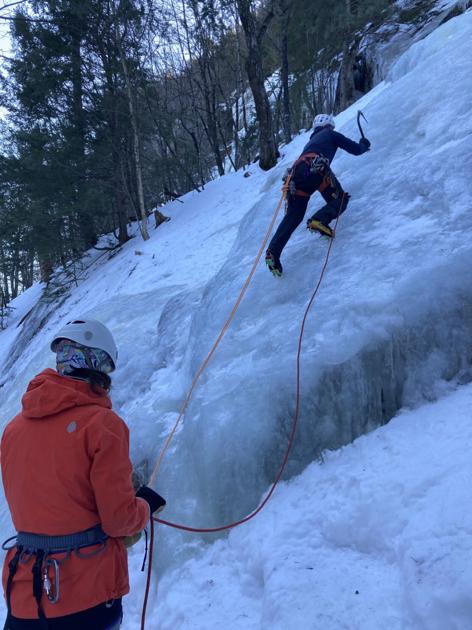I ce climbing is daunting. The sight of frozen blue towers cascading down exposed rock, the accuracy needed to swing the tools just right and the demanding athleticism have drawn me to the challenge of this winter sport.
The professionals at the International Mountain Climbing School recently introduced me to longtime climbing guide Paul McCoy.
Traveling around the country fly-fishing with his father as a child, McCoy met and learned from many guides his dad hired. Those trips catalyzed his desire to become a guide one day.
“I knew from a pretty young age it was something I wanted to do,” he said.
Arriving at the IMCS shop in downtown North Conway, I was fitted with all of the proper gear for an ice-climbing lesson: rigid mountaineering boots with a cushiony liner to trap the warmth, two ice axes with aggressive picks to position into the wall, and crampons — a foot-traction system with sharp teeth-like points to help dig into the ice.
Climbing harnesses, helmets, ropes and ice screws piled up around our chairs as our group discussed the plan and prepared to head out for a beautiful afternoon in the Mount Washington Valley.
At the shaded north end of Cathedral Ledge, a frequent climbing destination and our selected spot, McCoy reviewed some safety tips. He explained how to carry an ice ax on an incline and warned us to watch out for falling ice (one reason for keeping on our helmets).
Next, he set us up for top roping, a style of climbing in which the climber is attached to a rope anchored in the ice above them and belayed by someone from the ground. The belayer skillfully handles the rope through a device to stop the climber in case of a slip.
As someone who learns best from observation, I watched as two other participants eagerly tied their figure-eight knots, securing the climbing rope into their harnesses.
As the pair worked their way up the ice, McCoy explained that a climbing zone’s difficulty rating is based on a variety of factors, such as the steepness of the pitch, the quality of the ice and the length of the route.
We started on the North End Slab, a mellow WI (water ice) 2 grade, simply getting the hang of the movements and our equipment before graduating to a slightly longer and steeper route known as The Pillars, a WI 3-4.
On the steeper pitch, McCoy demonstrated a tripod stance for climbing. The triangle helped me feel more supported on the ice. The idea was to keep the ice ax centered and your feet out wide. When you want to move upward, you bring both feet up first, then kick each foot out to secure your position before swinging the next ax further up.
Of course, we all know the saying: What goes up must come down. I was soon reminded of this (and my slight fear of heights) when I began rappelling down the frozen waterfall I had just conquered. The frightening thing, at first, is putting all of your trust in your belayer as you lean far away from the ice and slowly maneuver, flatfooted, back to stable ground.
Ice climbing was a new activity that took me out of my comfort zone, as evidenced by the soreness in my hands from death-gripping the axes. But it also was empowering to tackle such a challenge.
“It’s scary, and I always learn something every time I go,” McCoy said. “Sometimes I don’t make it up things, and that’s OK. You learn a lot about yourself.”
Winter Notes appears Fridays in the New Hampshire Union Leader through ski season. Contact Jill Armstrong jaarmstr1@gmail.com.
Credit: Source link































